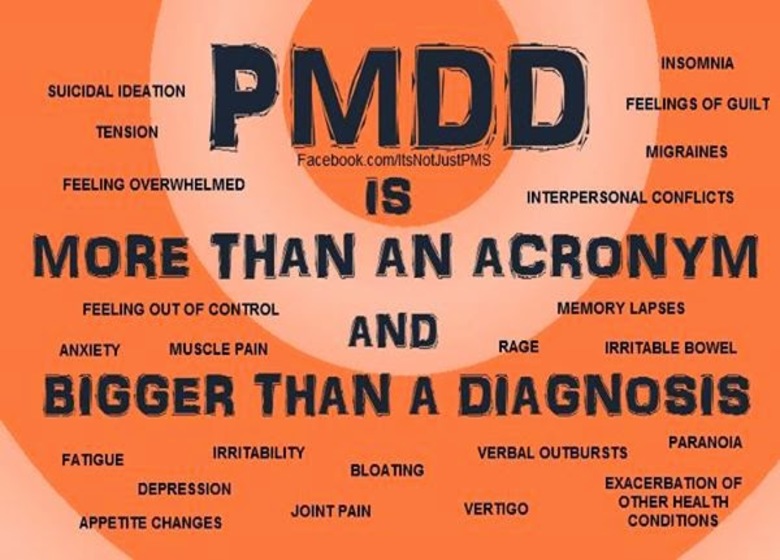What is Premenstrual Dysphoria Disorder (PMDD)?
Premenstrual dysphoric disorder (PMDD) is a very severe form of premenstrual syndrome (PMS), which can cause many emotional and physical symptoms every month during the week or two before you start your period. It is sometimes referred to as ‘severe PMS’.
While many people who are able to have periods may experience some mild symptoms of PMS, if you have PMDD these symptoms are much worse and can have a serious impact on your life. Experiencing PMDD can make it difficult to work, socialise and have healthy relationships. In some cases, it can also lead to suicidal thoughts.
Symptoms
According to the diagnostic criteria for PMDD as outlined in the American Psychiatric Association’s Diagnostic and Statistical Manual of Mental Disorders (DSM):
- You must have five or more severe symptoms that occur during the time between ovulation and your period.
- These symptoms must go away during your period and not return for at least another couple of weeks when your next luteal phase starts.
- These symptoms must also interfere with your work or school, your relationships with family, friends, and/or coworkers and your usual social activities.
You have to have at least one of the following symptoms to have the diagnosis of PMDD:
- very labile moods like mood swings, increased sensitivity to rejection, and/or sudden sadness or tearfulness
- marked irritability or anger
- depressed mood
- marked anxiety and tension
In addition, you may also have any one or more of the following symptoms to make a total of five or more symptoms:
- decreased interest in your usual activities
- difficulty concentrating
- lack of energy
- overeating or food cravings
- changes in your sleep habits
- feeling overwhelmed or out of control
- physical symptoms like breast tenderness or swelling, joint pain or muscle aches, feeling bloated, and or weight gain
Common Causes
As a mood disorder, PMDD is believed to be triggered by fluctuating hormone levels altering the production or effectiveness of neurotransmitters, including serotonin and dopamine.
Hormones
Reproductive hormones—namely estrogen and progesterone—interact with brain chemicals and can influence mood. Estrogen and progesterone are produced by the ovaries and the levels of these hormones fluctuate during a regular menstrual cycle.
PMDD is not necessarily the result of a hormonal imbalance or deficiency, though your doctor will probably run tests to rule that out.
Progesterone/Allopregnanolone
PMDD symptoms are limited to the luteal phase of the menstrual cycle, which occurs between ovulation and the first day of bleeding. In a typical 28 day menstrual cycle this corresponds to cycle days 14 to 28.
At ovulation, the ovaries begin to increase the production of progesterone, which is then converted into allopregnanolone (ALLO). Progesterone and ALLO levels continue to rise until the start of your period, at which point they rapidly drop.
The exact cause is not known, but researchers have two theories: women with PMDD either experience a change in GABA-receptor sensitivity to ALLO in the luteal phase or there is a defect in ALLO production during the luteal phase.
Estrogen
After ovulation, estrogen levels drop. Estrogen interacts with several brain chemicals that control your mood, in particular, serotonin. Serotonin is important for regulating many functions, including mood, sleep, and appetite. Serotonin also influences your cognition, or how you acquire, process, and perceive information from your environment. Estrogen promotes the positive effects of serotonin.
Women with PMDD may experience an exaggerated drop in serotonin levels. Low serotonin levels are associated with the depressed mood, food cravings, and impaired cognitive functioning of PMDD. This is why selective serotonin receptor inhibitors (SSRIs) is the top treatment for PMDD.
Immune Activation and Inflammation
Mood disorders are linked to the immune system. Infections and other causes of systemic inflammation can trigger a worsening of symptoms in patients with mental health issues.
Genetics
There is a genetic basis for the hormonal sensitivities that appear to be at work in PMDD. Researchers at the National Institute of Health found that women with PMDD have changes in one of the gene complexes that control how they respond to estrogen and progesterone.
This discovery is extremely validating if you have PMDD. It gives concrete scientific evidence that something biological and beyond your control is causing your mood changes.
Lifestyle Risk Factors
Some, but not all, women with PMDD have a history of significant stress exposure, such as a history of childhood physical, emotional, or sexual abuse. Everyday stress can also trigger symptoms or make them worse.
The correlation between stress and worsening PMDD symptoms is currently an area of active investigation. Researchers are looking at the relationship between ALLO and the stress response in women with PMDD. ALLO typically increases at times of acute stress and has a calming and sedative effect. Experimental studies suggest the ALLO response to acute stress is decreased when exposed to chronic stress.
Certainly, the possibility of a connection between your stress response and PMDD supports the common sense first line treatment interventions for PMDD, including lifestyle modifications and stress reduction.
Diagnosis of PMDD
At-Home Testing
If you suspect you have PMDD, you can take an online screening assessment through the International Association for Premenstrual Disorders website.
This self-screen goes over various symptoms that occur following ovulation during the luteal phase of your cycle, which is typically seven to 14 days prior to your period. It is not intended to diagnose the condition or replace the care of a medical practitioner but rather serves as an indicator for further investigation.
Through labs and tests
Since PMDD is a mood disorder, it cannot be diagnosed through blood tests or imaging. However, your doctor may order blood tests to rule out other potential causes, such as altered hormone levels or thyroid problems.
Coping
Living with PMDD can be challenging.
In addition to medication, women with PMDD may find some relief using holistic techniques, relaxation exercises, stress relief, and diet in the week before their period. Here are some methods that are also suggested for easing PMS symptoms:
- Eat right. Follow the rules of good nutrition. Health experts recommend that women with PMDD limit their intake of salt, caffeine, refined sugar, and alcohol.
- Take supplements. Calcium, vitamin B6, vitamin E, and magnesium are recommended for easing PMS and PMDD.
- Reduce stress. PMDD is cyclical, so you have a good idea of when it will resurface. When possible, lower your expectations for productivity or social commitments for the week before your period, and try to incorporate stress relieving techniques, such as deep breathing or meditation. Book yourself a massage, pedicure, reflexology, or other types of pampering session during this time.
- Get exercise. Even light exercises, like walking, yoga, or tai chi, can help to relieve symptoms.
- Seek professional mental health care. Some women suffering from the symptoms of PMDD also seek out counseling. Therapy can help you to develop effective coping strategies.
PMDD is a real condition and left untreated may have a serious impact on your health and well-being. You must take a professional opinion before following any treatment procedure. Let your friends or loved ones know about it and allow people to help you.
Also read : Premenstrual Syndrome (PMS) – Symptoms and treatment













